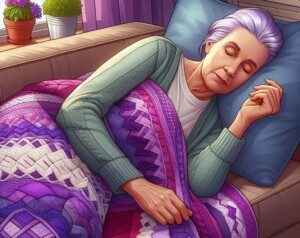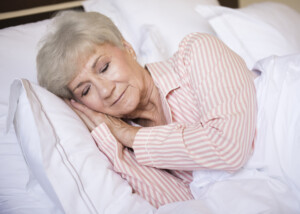How much daytime sleeping is too much for the elderly hip replacement patient who just returned home?
Restorative sleep is a wonderful thing, and sleep deprivation is linked to a myriad of health ailments.
But too much of a good thing can be quite harmful, and sleeping in the daytime, when you already sleep overnight, is no exception to this rule.
How does daytime napping, however, apply to the elderly hip replacement patient?
“Daytime sleeping is fine,” begins Kamala Littleton, MD, orthopedic surgeon with Orthopedics and Joint Replacement at Mercy Medical Center in Baltimore, Maryland. Dr. Littleton is board certified and specializes in joint, hip and knee replacement and reconstruction.
“The fracture and the surgical intervention take a lot out of older patients so they need more rest,” she continues.
“They do need to get out of bed, exercise and walk several times a day. Spending most of the day in a recliner rather than bed is preferred.”
What this means is that the recliner is preferable to the bed, by far. But it does not mean, literally, that the older hip replacement patient should spend most of the day in a recliner. They should be up and about as much as they can tolerate.
The comfort zone is the recliner. The elderly hip replacement patient should be encouraged to leave this comfort zone.
This doesn’t mean they shouldn’t take rests including some snoozers. But too much recliner time, and especially bed rest, bring some serious risks.
“Too much time in bed puts one at risk for blood clots and pneumonia. but I have no problem with napping,” says Dr. Littleton. And what is a nap? A nap may be 20-30 minutes.
If the nap is for too long, the patient will start entering a deeper sleep cycle, and then when they finally get up, they’ll feel groggy and listless.
Several 20-minute naps throughout the day, for example, are beneficial. This should never transform into excessive sleeping or bed rest. Snoozing in a chair, rather than a bed, is less likely to result in an extended period of sleep.
Too much sitting, even in an upright chair, is a bad thing for the elderly hip replacement patient, because it will force the soft tissues around the hip to be in a prolonged “L” position (shortening the muscles), so that when the patient finally stands up and walks…there may be a lot of pain from the stiff, retracted muscles being stretched.
Excessive daytime sleeping, as mentioned, increases the risk of pneumonia, and via more than one pathway.
One of those pathways is that the lungs, being in a lying or reclined position, and even in an upright sitting position, are not in their ideal state in which they can open up with optimal efficiency and take in air.
In fact, the elderly hip replacement patient may be prone to sitting slouched, “crumpling” up the organs.
Being up and about more frequently opens the abdominal cavity up, giving the lungs more room, making breathing easier.
 Dr. Littleton offers years of experience and specialized training to perform anterior hip replacement as well as MAKO knee resurfacing and knee replacement. She also performs shoulder surgery.
Dr. Littleton offers years of experience and specialized training to perform anterior hip replacement as well as MAKO knee resurfacing and knee replacement. She also performs shoulder surgery.
 Lorra Garrick has been covering medical, fitness and cybersecurity topics for many years, having written thousands of articles for print magazines and websites, including as a ghostwriter. She’s also a former ACE-certified personal trainer.
Lorra Garrick has been covering medical, fitness and cybersecurity topics for many years, having written thousands of articles for print magazines and websites, including as a ghostwriter. She’s also a former ACE-certified personal trainer.
.










































